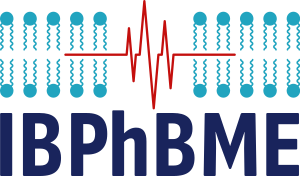 Institute of Biophysics and Biomedical Engineering at the Bulgarian Academy of Sciences is a recognized national leader in the field of biophysics and biomedical engineering. Proof of this is the 2017 assessment of the Expert Committee for Monitoring, Evaluation and Analysis of Research at the Ministry of Education, according to which IBPhBME–BAS is ranked first in the most prestigious group of elite organizations in the field of Biological Sciences and Biotechnologies.
Institute of Biophysics and Biomedical Engineering at the Bulgarian Academy of Sciences is a recognized national leader in the field of biophysics and biomedical engineering. Proof of this is the 2017 assessment of the Expert Committee for Monitoring, Evaluation and Analysis of Research at the Ministry of Education, according to which IBPhBME–BAS is ranked first in the most prestigious group of elite organizations in the field of Biological Sciences and Biotechnologies.
Presently, IBPhBME–BAS is an institution with established national and international reputation in the fields of biomolecular analysis, detection of membrane-related dysfunctions in various socially significant human diseases, development of algorithms, software and hardware in the field of electrocardiology, of tools for critically ill patients of intensive care units, of apparatuses for cardio-pulmonary resuscitation, of algorithms for neurophysiological diagnostics and treatment, for treatment of skin tumours by means of electroporation devices.
Administrative Structure
Administratively IBPhBME-BAS is built up of eight departments and a laboratory, and conducts research in the following priority areas of research:
- Biomacromolecules and Biomolecular InteractionsBiofunctionalization of solid surfaces and optimization of their biocompatibility for use in medicine. Dynamics of biological macromolecules and structure / function relationship. Thermal stability of proteins and complex biological systems. Macroorganization of pigment-protein complexes, factors modulating their conformation, integrity and function. Serum proteome microcalorimetry.
- Photoexcitable MembranesMechanisms of light energy transduction in biological membranes. Role of the structural organization of pigment-protein complexes, lipid composition and physicochemical properties of thylakoid membranes for the effectiveness of primary photosynthetic processes. Pigment-lipid interactions in model membranes; mechanisms of adaptation of photosynthetic apparatus. Role of lipid-protein interactions in response of photosynthetic organisms to environmental changes. Involvement of reactive oxygen species in stress-induced inactivation processes. Development of biosensors using photosynthetic membranes.
- Analysis and Processing of Biomedical Signals and DataApproaches for ECG signal acquisition, preprocessing, analysis and visualisation. Algorithms for ECG wave boundary detection, for time and amplitude parameter measurement and for diagnostic classification. Heart rate variability analysis methods, yielding higher spectrum width and accuracy. Method and instrumentation for electrochemotherapy of malignant tumours by introduction and application of short bursts of biphasic pulses. Effective and safety defibrillation waveforms with automatic adjustment of the chopping-modulated pulses to patient transthoracic resistance. Morphological indicators of heart beat and automatic heart beat classification in arrhythmia analysis. ECG heart beat detection methods. Method for analysis of the QT dispersion.
- Lipid-Protein InteractionsStructural organization and functional activity of biological membranes under normal and pathological conditions. Lateral organization of membrane lipids, transmembrane signal transduction and phospholipid asymmetry. Experimental approaches of modulation of the level of cholesterol and polyunsaturated fatty acids, oncogene-induced transformation, lipid peroxidation, cell cultivation in three-dimensional conditions etc. Influence of the lipid molecules, related to certain pathological processes on the phase behaviour of lipids and structural organization of the lipid bilayer. Giant unilamellar vesicles and и interaction of active macromolecules with the lipid bilayer.
- QSAR and Molecular ModellingQuantitative structure-activity relationships (QSAR) and molecular modelling approaches for characterizing the relationship between the structure of chemical compounds and their biological effect. Ligand-based and structure-based approaches, including: pharmacophore modelling, molecular fields analysis, homology modelling of proteins, docking and virtual screening of bioactive compounds, identification and analysis of protein-lignad interactions, formation of chemical categories using different chemometrical methods.
- Electroinduced and Adhesive PropertiesElectroporation, electrofusion and electrotransformatiom. Electrotransfer of macromolecules through lipid membranes. Electrical properties of biological membranes. Electrochemotherapy of tumour cells. Cell adhesion and reorganization of cytoskeleton after electrotreatment. Influence of low voltage, low frequency electric field on the adhesive properties of nanostructures (tissue engineering). Electroporation and electrotransformation methods, patch clamp, fluorescent method for measuring of transmembrane potentials, radioisotope methods, determination of particle electrophoretic mobility, DNA fragmentation, MMT test, FACS analysis.
- Bioinformatics and Mathematical ModellingGeneralized nets for modelling of complex, parallel and concurrent processes, and their application in medicine, biology and other areas. Intuitionistic fuzzy sets and their application to decision making under uncertainty, including InterCriteria Analysis. Information technologies and smart systems for decision support of the diagnostic and therapeutic process in the practical healthcare. Biology and nature-inspired computational algorithms and metaheuristics.
- Motor ControlInvestigation of biomechanics and motor control of the human limbs, modelling and simulation of the motor activity at the muscle and motor units level. Experimental methods for estimation of muscle activity in norm and pathology. Mathematical modelling of nerves and skeletal muscles in norm and pathology for improving the diagnostics and methods of treatment of neurological and neuromuscular disorders. Relationship between intra- and extra-cellular action potentials of excitable cells and estimation of their functional status under physical and chemical impacts.
Memberships
IBPhBME is a partner organization in the Project “Research Infrastructure Cell Technologies in Biomedicine (INFRAACT)”, which is in the process of joining EATRIS-ERIC.
Hits: 132

